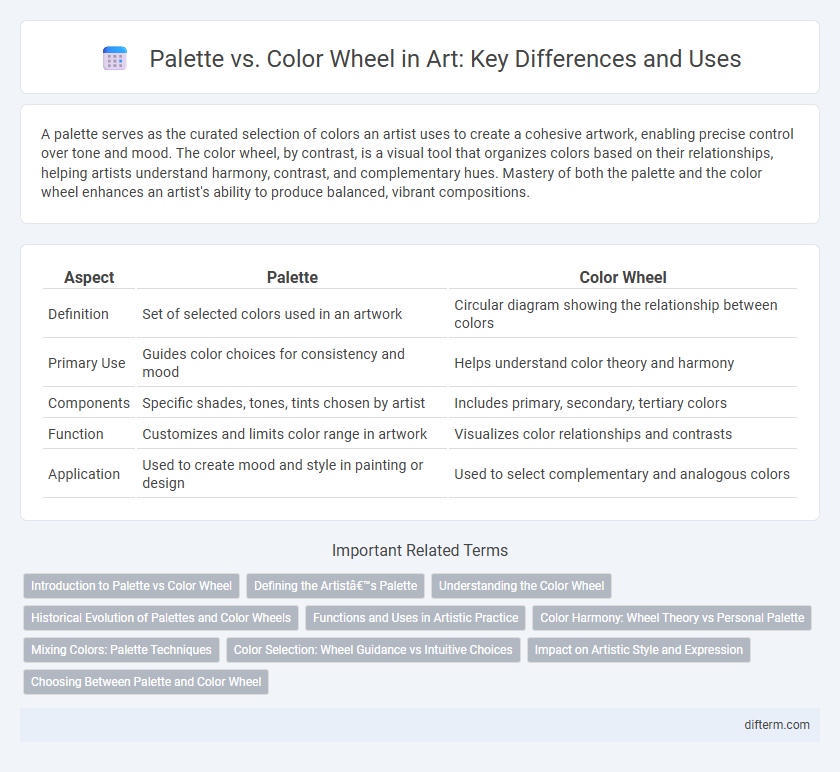A palette serves as the curated selection of colors an artist uses to create a cohesive artwork, enabling precise control over tone and mood. The color wheel, by contrast, is a visual tool that organizes colors based on their relationships, helping artists understand harmony, contrast, and complementary hues. Mastery of both the palette and the color wheel enhances an artist's ability to produce balanced, vibrant compositions.
Table of Comparison
| Aspect | Palette | Color Wheel |
|---|---|---|
| Definition | Set of selected colors used in an artwork | Circular diagram showing the relationship between colors |
| Primary Use | Guides color choices for consistency and mood | Helps understand color theory and harmony |
| Components | Specific shades, tones, tints chosen by artist | Includes primary, secondary, tertiary colors |
| Function | Customizes and limits color range in artwork | Visualizes color relationships and contrasts |
| Application | Used to create mood and style in painting or design | Used to select complementary and analogous colors |
Introduction to Palette vs Color Wheel
A palette is a physical or digital tool that holds selected colors an artist uses for a specific artwork, allowing precise control over color mixing and harmony. In contrast, the color wheel is a circular diagram showing the relationships between primary, secondary, and tertiary colors, serving as a foundational guide for understanding color theory and combinations. While the palette customizes actual color application, the color wheel provides a theoretical framework essential for effective color choice and contrast in art.
Defining the Artist’s Palette
The artist's palette is a physical or digital surface where colors are mixed and prepared for application, emphasizing personal selection and blending tailored to the artist's vision. Unlike the color wheel, which organizes hues in a systematic, circular arrangement to illustrate relationships such as complementary and analogous colors, the palette reflects the practical combination of pigments used in the creation of artwork. Mastery of the palette enables precise control over tone, saturation, and harmony, directly influencing the emotional and visual impact of the piece.
Understanding the Color Wheel
The color wheel is a circular representation of hues that organizes primary, secondary, and tertiary colors based on their chromatic relationships, essential for understanding color harmony and contrast. In contrast, a palette refers to the specific selection of colors an artist chooses for a painting, often blending pigments to achieve desired tones and moods. Mastery of the color wheel enhances an artist's ability to mix colors accurately and create visually balanced compositions.
Historical Evolution of Palettes and Color Wheels
The historical evolution of palettes and color wheels reflects significant advancements in the understanding of color theory and pigment availability. Early artists relied on limited natural pigments arranged on rudimentary palettes, while the 18th-century invention of the color wheel by Isaac Newton revolutionized color mixing and harmony perception. Modern palettes integrate synthetic pigments with the structured guidance of color wheels, enhancing artistic creativity and precision in color selection.
Functions and Uses in Artistic Practice
A palette serves as the physical surface where artists mix and manipulate pigments to achieve custom hues and tones, integral for personalized color blending in painting. The color wheel, a circular diagram of primary, secondary, and tertiary colors, functions as a theoretical tool to understand color relationships, harmonies, and contrasts in composition. Together, these tools facilitate precise color decision-making and enhance creative expression by linking practical mixing techniques with color theory principles.
Color Harmony: Wheel Theory vs Personal Palette
Color harmony in art hinges on the contrast between the color wheel's systematic approach and the intuitive selection of a personal palette. The color wheel offers a structured understanding of complementary, analogous, and triadic schemes based on color theory principles. Conversely, personal palettes prioritize emotional resonance and unique artistic expression, often blending unconventional hues beyond the wheel's traditional confines.
Mixing Colors: Palette Techniques
A palette offers a flexible surface for blending and experimenting with custom hues, enabling artists to precisely control pigment ratios and achieve unique color variations. The color wheel serves as a visual guide for understanding relationships between primary, secondary, and tertiary colors, helping artists predict color mixing outcomes and harmonious combinations. Mastery of palette techniques combined with color wheel theory enhances the ability to create balanced, saturated, or muted tones tailored to artistic expression.
Color Selection: Wheel Guidance vs Intuitive Choices
The color wheel provides a structured guide for selecting harmonious hues based on relationships like complementary, analogous, and triadic schemes, crucial for achieving balance in artwork. In contrast, palette-based intuitive choices rely on personal perception and emotional response, fostering unique and expressive color combinations beyond traditional rules. Both methods offer valuable approaches to color selection, blending scientific principles with creative freedom to enhance visual impact in art.
Impact on Artistic Style and Expression
The palette shapes an artist's unique style by dictating color combinations, enabling distinct moods and emotional depth in artwork. The color wheel provides a foundational tool for understanding color relationships, informing choices such as complementary or analogous schemes that enhance visual harmony. Together, the palette and color wheel influence artistic expression, guiding both creativity and technical precision in color application.
Choosing Between Palette and Color Wheel
Choosing between a palette and a color wheel depends on the specific artistic goals and workflow preferences. A palette offers a curated selection of colors, enabling artists to maintain color harmony and thematic consistency throughout their work. In contrast, a color wheel provides a comprehensive visual guide for understanding color relationships and creating balanced compositions through complementary, analogous, and triadic schemes.
palette vs color wheel Infographic

 difterm.com
difterm.com